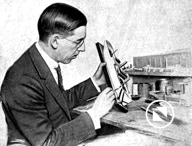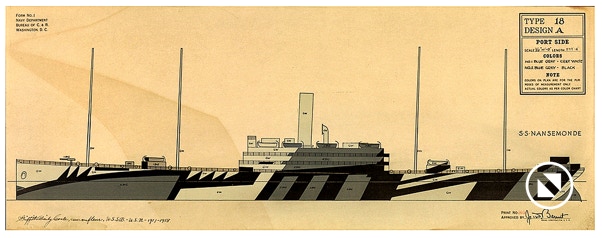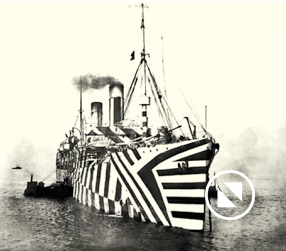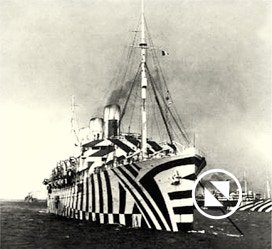PLANS
Based on research by
Roy R. Behrens, as published in FALSE COLORS: Art, Design and Modern Camouflage (2002); CAMOUPEDIA: A Compendium of Research of Art, Architecture and Camouflage (2009); and SHIP SHAPE: A Dazzle Camouflage Sourcebook (2012)
MARINE CAMOUFLAGE
Use In Warfare. Kalgoorie Miner (W Australia)
April 1, 1919, p. 6—
A model of a camouflaged ship is placed on a board behind a screen. In the screen is a periscope, to which the experimenting look-out man applies his eye. He is asked to indicate the course of the ship he sees on a compass dial by his side. This indication is then compared with the direction in which the ship’s bows are actually pointing;
and the discrepancy between the two is found to be wide—as a rule, ludicrously wide. Similar demonstration theatres were set up at the ports for the persuasion of skeptical mariners, whose discomfiture was exceeding when they discovered how far “Dazzle” had led astray their wiliest perception. From the Academy school practically every maritime allied nation has been trained. All the American destroyers and patrol boats have been painted with designs supplied by Commander Wilkinson and his assistants. France sent over four officers for lessons, and then started a “Dazzle” section of her own in Paris. Italy was supplied with the British plans and designs. At the request of the United States Navy Department and the Shipping Corporation, Commander Wilkinson went to America to advise, with the result that his scheme was adopted.
Right Photographs of two different dazzle-painted British ships. Their camouflage schemes are derived from the same distortion plan, but a closer look reveals that they are far from identical.
William Andrew Mackay (c1918)
•••
CAMOUPEDIA
Models, plans, paintings and photographs of Allied ship camouflage from World War I
Above Color lithograph of a US dazzle camouflage plan (port side). Apparently, 495 plans like this were prepared and then printed in multiples by the US Geological Society. Those that survived (their condition varies widely) are housed in various collections. This particular print (prepared at the US Navy’s Camouflage Design Subsection in Washington DC) is signed at the bottom left by American artist Griffith Baily Coale. He may have owned the print, but most likely he didn’t design it, because he was on the ship painting team at the Baltimore Shipyards, not on the navy camouflage team in Washington DC.
Even though hundreds of dazzle camouflage plans were produced during WWI (some printed in multiples), we should probably be surprised that so many have survived. The British seem to have been more successful than the Americans at preserving the plans and the models. Quite a few of the British ship models are still intact, as are many of the plans.
It appears that very few wooden ship models have survived in the US. There are incomplete sets of the colored lithographic plans at the National Archives and Records Administration, and the Fleet Library at the Rhode Island School of Design, with smaller numbers in other collections. Aside from inventory listings and online posted items, it is impossible know how many additional models, plans and photographs are still in government storage.
In the private sector, more artifacts are discovered each year, as collectors and historians gain access to the contents of heretofore private estates.
There are apparently no full-color photographs of WWI camouflaged ships, because color photography (as we know it) had not yet been perfected. But there are on-site paintings and drawings by artists of dazzle-painted vessels, and there are thousands of black and white photographs of the same ships in government archives and elsewhere.
As for the plans, it should be noted that the two sides of a ship were not identical—the more different they were, the better perhaps. At first, it was planned that no two ships would have the same camouflage, but that was soon abandoned because of the workload. As a result, the same scheme might be designed to fit a specific type of ship, and then, if needed, it could also be modified to function as well on another different type of ship. That modification was usually done by civilian camoufleurs at the docks, so that, even though they were forbidden to initiate new designs, they no doubt enjoyed some liberties in adapting an existing scheme.



